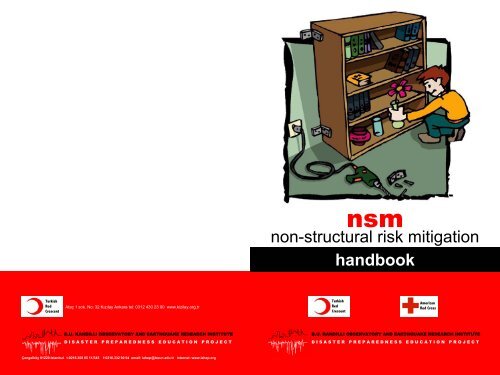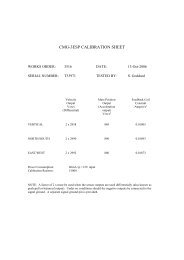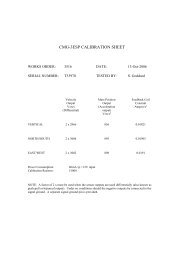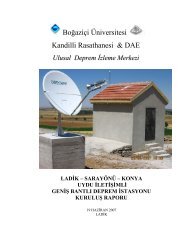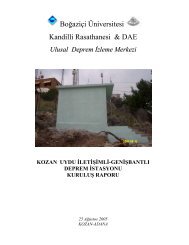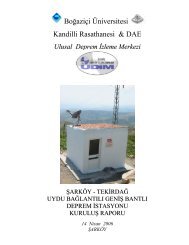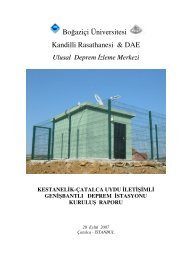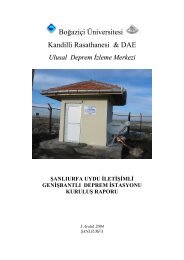NSM Handbook
NSM Handbook
NSM Handbook
Create successful ePaper yourself
Turn your PDF publications into a flip-book with our unique Google optimized e-Paper software.
nsm<br />
non-structural risk mitigation<br />
handbook<br />
Turkish<br />
Red<br />
Crescent<br />
Ataç 1 sok. No: 32 Kızılay Ankara tel: 0312 430 23 00 www.kizilay.org.tr<br />
Turkish<br />
Red<br />
Crescent<br />
American<br />
Red Cross<br />
B.U. KANDILLI OBSERVATORY AND EARTHQUAKE RESEARCH INSTITUTE<br />
D I S A S T E R P R E P A R E D N E S S E D U C A T I O N P R O J E C T<br />
B.U. KANDILLI OBSERVATORY AND EARTHQUAKE RESEARCH INSTITUTE<br />
D I S A S T E R P R E P A R E D N E S S E D U C A T I O N P R O J E C T<br />
Çengelköy 81220 Istanbul t:0216.308 05 11/345 f:0216.332 90 94 email: iahep@boun.edu.tr internet: www.iahep.org
Non-Structural Risk Mitigation <strong>Handbook</strong><br />
Turkish<br />
Red<br />
Crescent<br />
American<br />
Red Cross<br />
This project was funded by American Red Cross with generous support from Boğaziçi<br />
University, Disaster Preparedness Education Project, Kandilli Observatory and Earthquake<br />
Research Institute, Boğaziçi University Center for Disaster Management, and Turkish Red<br />
Crescent. The opinions expressed herein are those of the author(s) and do not necessarily<br />
reflect the views of the American Red Cross.<br />
What is your wall or structural element type?<br />
authors:<br />
Rebekah Green, MSCE, Project Coordinator<br />
Ömer Çalışkan, Trade School Teacher<br />
Brick Masonry Concrete Aircrete Gypsum Timber<br />
Board<br />
Bilgen Sungay, Architect<br />
advisors:<br />
Zara Paci, Educator<br />
Marla Petal, MSW, Disaster Preparedness Education Project Director<br />
Prof. Dr. Özal Yüzügüllü, B.U. Prof. of Earthquake Engr.<br />
How heavy<br />
is your<br />
furniture?<br />
Plastic<br />
Masonry<br />
Wall Plugs<br />
Standard<br />
Wall Plugs<br />
Steel<br />
Expansion<br />
Bolts<br />
Plastic<br />
Aircrete<br />
Wall Plugs<br />
Gypsum<br />
Wall Plugs<br />
Wood Lag<br />
Screws<br />
Utku Celep, MSEE<br />
Cüneyt Tuzun, MSCE<br />
0- 5 kg.<br />
For light objects use<br />
size 6 Standard Wall Plugs<br />
Size 10<br />
Size 2<br />
Size 3<br />
4 mm. x<br />
60 mm.<br />
graphic designer:<br />
illustrators:<br />
Burcu Kayalar<br />
Atila Ulaş<br />
Baran Baran<br />
This publication was made possible through the support provided by the Office of Foreign<br />
Disaster Assistance, U.S. Agency for International Development, under the terms of Award<br />
No. AOT-G-00-00-00235-00. The opinions expressed herein are those of the author(s) and<br />
do not necessarily reflect the views of the U.S. Agency for International Development.<br />
© Copyright 2003, Marla Petal, Rebekah Green, Boğaziçi University, Disaster Preparedness<br />
Education Project, Kandilli Observatory and Earthquake Research Institute, and the Center<br />
for Disaster Management.<br />
Turkish edition by Beyaz Gemi Publishers.<br />
5 -50 kg.<br />
Size 6<br />
50 -150 kg. Size 8<br />
It is best if plastic<br />
masonry wall plugs<br />
are long enough to<br />
pass through 2 holes<br />
in the clay tile in<br />
order to hold more<br />
securely.<br />
Size 6<br />
Leave a<br />
16 cm.<br />
space<br />
between<br />
expansion<br />
bolts<br />
For items this<br />
heavy, attach<br />
directly to studs or<br />
use a wall bridge.<br />
150 kg. + To secure very heavy items, consult a engineer or<br />
professional for proper installation.<br />
NOTES:<br />
Size 7<br />
Size 8 Size 8<br />
Leave a<br />
15 cm.<br />
space<br />
between<br />
aircrete<br />
wall plugs<br />
Size 2:<br />
10 mm.<br />
board<br />
Size 3:<br />
12 mm.<br />
board<br />
4 mm. x<br />
60 mm.<br />
6 mm. x<br />
80 mm.<br />
B.U. KANDILLI OBSERVATORY AND EARTHQUAKE RESEARCH INSTITUTE<br />
D I S A S T E R P R E P A R E D N E S S E D U C A T I O N P R O J E C T<br />
Çengelköy 81220 Istanbul t:0216.308 05 11/345 f:0216.332 90 94 email: ahep@boun.edu.tr www.ahep.org
nsm<br />
FAMILY DISASTER<br />
PREPAREDNESS PLAN<br />
36<br />
Enter date of completion:<br />
We held a family meeting to discuss our Family Disaster Plan.<br />
We identified the safest places in the house, and in each room.<br />
(Away from windows, large and heavy objects that can fall, and<br />
objects like heaters that can cause fire.)<br />
We identified exits and alternative exits from our house and building.<br />
We considered the special provisions we need for pets, people who<br />
don't speak the language of the country, elderly, disabled, and small<br />
<br />
children.<br />
We have enough water to last us a week (4 liters per person per day),<br />
and food for 3 days.<br />
We know how to turn off our electricity, water and gas.<br />
We know our out-of-area contact person(s) and phone number(s):<br />
It's:<br />
We know where we would reunite<br />
Inside the house:<br />
______________<br />
Outside the house:______________________________________<br />
Outside the neighborhood:<br />
We know how to use a fire extinguishers.<br />
We keep shoes and flashlights by our beds.<br />
We have a good first aid kit.<br />
We collected our survival supplies, and made up our earthquake<br />
bags. (Flashlight, batteries, radio, first aid kit, change of clothes,<br />
cash, whistle, matches, 1 week prescription medication, paper<br />
and pencil, important phone numbers.)<br />
We made our copies of important documents, and key addresses<br />
and phone numbers, and keep them in our earthquake bag or with<br />
our out-of-area contact.<br />
We know never to light a match, lighter, or any other flame after an<br />
earthquake until we are sure there is no danger of escaping gas<br />
anywhere around.<br />
We're starting to spread the word to everyone we know.<br />
We know that we will only use the telephone in an emergency after<br />
an earthquake, so that the lines will be there for those who need<br />
them most. We will get our information from TV and radio.<br />
We have completed our Earthquake Hazard Hunt and have taken<br />
measures to protect ourselves.<br />
We plan to review our plan again every 6 months.<br />
name<br />
address<br />
telephone<br />
e-mail<br />
date<br />
______________<br />
nsm<br />
PREFACE<br />
The methods suggested in this education for reducing non-structural<br />
risk were based upon 8 months of research, testing, and calculations.<br />
This was done by a team of researchers at Boğaziçi University,<br />
Disaster Preparedness Education Project (DPEP), Kandilli Observatory<br />
and Earthquake Research Institute (KOERI), and the Center for<br />
Disaster Management (CENDIM).<br />
Research:<br />
Many of the suggestions in this education are based upon reports from<br />
past earthquake experiences and recommendations from governmental<br />
agencies in earthquake regions around the globe. Local industrial<br />
specialists were also consulted. In addition, countless people were<br />
interviewed regarding what they had done to reduce their risk. Their<br />
ideas were considered and their questions and concerns were taken<br />
into account.<br />
Laboratory Tests:<br />
Electronic equipment, white appliances, and large furniture items were<br />
attached to wall materials on a shake table using a variety of fastener<br />
types and installation methods. Effective and ineffective attachment<br />
methods were learned through hundreds of tests.<br />
Shake Table: A platform attached to a<br />
computer and large motor. The motor and<br />
computer can cause the platform to shake<br />
similar to ground motion from an<br />
earthquake. A single degree of freedom<br />
shake table was used in our tests. It can<br />
only shake in one direction, forwards and<br />
backwards. It cannot move up and down<br />
or side to side like a true earthquake. A 6<br />
degree of freedom shake table can fully<br />
simulate an earthquake.<br />
Calculations:<br />
When there were no tests or past research, engineering calculations<br />
were used. Recommendations for the size and number of attachments,<br />
wall plugs, and screws are based upon the International Building Code<br />
as well as manufacturer’s guidelines.<br />
1
nsm ACKNOWLEDGEMENTS<br />
2<br />
Research regarding non-structural damage in earthquakes is a new<br />
field. Even newer are the ideas for reducing these risks. While people<br />
all over the world have found simple and innovative ways for reducing<br />
their risk, there are still many unanswered questions and puzzling<br />
problems. Everyone can play a part in finding solutions for these<br />
problems. Citizens should reduce the risks in their own surroundings.<br />
After an earthquake, they can also investigate how non-structural<br />
mitigation worked in homes, schools, and work places. Scientists and<br />
engineers can do further research and calculations. Technicians,<br />
entrepreneurs, handymen and even ordinary citizens can think of new<br />
earthquake safety products. It is only by working together that we can<br />
make our surroundings and communities safer and more resilient in the<br />
face of earthquakes.<br />
GOALS<br />
Major earthquakes can create devastating tragedies for a community<br />
including loss of life, injuries, loss of homes, work and community.<br />
However, we have learned from past earthquakes all over the world<br />
that much of this can be prevented. Many injuries, economic losses<br />
and even deaths can be avoided by simply making the items in our<br />
buildings safer during earthquakes.<br />
Our mission is:<br />
• To raise awareness regarding the risks that exist from nonstructural<br />
items.<br />
• To show how these risks can be identified.<br />
• To encourage everyone to take simple steps to reduce<br />
these risks.<br />
We would like to thank the Turkish Red Crescent Society and American<br />
Red Cross for seeing the value of this material and aiding in the<br />
development and dissemination of this education. This education<br />
program would not have been possible without the assistance of many<br />
people. We would especially like to thank the producers of nonstructural<br />
mitigation products for sharing their experience and donating<br />
their products.<br />
Adafix Endüstriyel Ürünler ve Hizmetler Tic. Ltd.Şti.<br />
Depsis Deprem Sistemleri Teknolojisi İnşaat ve Tic. Ltd.Şti.<br />
İNKA Yapı Boğlantı Elemanları Pazarlama Tic. Ltd.Şti.<br />
İnteryön<br />
Kaya Yapı San. Ve Tic. Ltd.Şti.<br />
TNT İmalat ve Ticaret<br />
We would like to thank the following companies for advising in their<br />
fields of expertise:<br />
3M San. ve Tic. A.Ş. Endüstriyel Bantlar Johnson Diversey<br />
ve Yapıştırıcılar Grubu<br />
Kelebek Mobilya ve Kontraplak San. A.Ş.<br />
AKPEN San. ve Tic. Ltd.Şti.<br />
Koç TAŞ Yapı Market<br />
Arçelik A.Ş.<br />
LİRTEK Yapı Ürünleri ve Sistemleri<br />
Asansör İnşaat San ve Tic. Ltd. Şti. MAY Mahalle Afet Yönetimi Derneği<br />
Bes-mak Sanayii ve Tic. A.Ş.<br />
Metal ve Yapı Sistemleri Tic. A.Ş.<br />
Buga Otıs Asansör San. ve Tic. A.Ş. Nalbur Birleşik Zincir Mağazalar A.Ş.<br />
Çelik Cam Plastik ve Alüminyum Pencere Okan Cam Sanayii ve Tic. A.Ş.<br />
Sistemleri<br />
Praktiker Yapı Marketleri A.Ş.<br />
Datakom Elektronik Mühendislik Ltd.Şti. Rena Mühedislik Taahhüt ve Tic. Ltd.Şti.<br />
Denge İnşaat Turizm San. Ve Tic. A.Ş. T.C. Emniyet Gen. Müd., İstanbul<br />
Edip Enerji Dizel A.Ş.<br />
Polis Hastanesi<br />
Gemini Büro Sistemleri ve Donatım Ltd. Şti. Tek-İz İzolasyon ve Yapı Elemanları<br />
Gülsan Şirketler Grubu<br />
San. A.Ş.<br />
Hakon Mühedislik Elektrik Elektronik Teleset Mobilya San. Ve Tic. Ltd.Şti.<br />
Ulaş Metal San. ve Dış Tic. Ltd. Şti.<br />
We are very grateful to the Ataşehir Rotary Club and Kandilli<br />
Observatory and Earthquake Research Institute who made the<br />
laboratory testing possible by allowing the use of their shake table.<br />
Disclaimer:<br />
Boğaziçi University, Kandilli Observatory and Earthquake Research<br />
Institute, and the Disaster Preparedness Education Project have tried to<br />
ensure the accuracy of this publication. However, earthquake<br />
engineering remains a new science and there is not enough information<br />
to fully predict the performance of non-structural items in future<br />
earthquakes, even if these guidelines are followed. Individual situations<br />
vary and it is the responsibility of the reader to carefully consider how to<br />
apply these recommendations to their own situation, and to seek expert<br />
guidance when in doubt. All parties assume no responsibility for the<br />
losses that may occur in an earthquake or as a result of applying these<br />
recommendations.<br />
35
nsm RESOURCES<br />
34<br />
This handbook includes information about basic non-structural<br />
mitigation. You can find out more information from your instructor,<br />
www.iahep.org or www.kizilay.org.tr about the following items:<br />
• Water Heaters<br />
• Stoves and Heaters<br />
• Signs, Air Conditioners,<br />
and Satellite Dishes<br />
• Suspended Ceilings<br />
• Pipes and Ducts<br />
• Masonry Walls<br />
• Chimneys<br />
• Non-structural Exteriors<br />
• Elevators, Escalators,<br />
and Moving Walks<br />
• Large and Sensitive Equipment<br />
ANCO Engineers Inc, Final Report on Seismic Testing of Your Calstraps Earthquake Safety Straps, 1994.<br />
ATC-Applied Technology Council, “Briefing Paper 6: Seismic Code Requirements for Anchorage of<br />
Nonstructural Components” ATC/SEAOC Joint Venture Training Curriculum (ATC-48).<br />
ATC-Applied Technology Council, Proceedings of Seminar on Seismic Design, Retrofit, and Performance<br />
of Nonstructural Components, 1998.<br />
ATC-Applied Technology Council, Proceedings of Seminar and Workshop on Seismic Design and<br />
Performance of Equipment and Nonstructural Elements in Buildings and Industrial Structures, 1992.<br />
Beall, Christine. Masonry and Concrete For Residential Construction. New York: McGraw-Hill, 2001.<br />
City of Seattle Emergency Management, Getting Ready…SDART’S Guide to Personal and Neighborhood<br />
Preparedness, 2002.<br />
Coburn, Andrew and Spence, Robin. Earthquake Protection. New York : Wiley, 1992.<br />
Drake, Richard and Bachman, Robert. “ NEHRP Provisions for 1994 Nonstructural Components.” Journal<br />
of Architectural Engineering. Vol. 2, no.1 (March 1996).<br />
Erdik, Mustafa. Report on 1999 Kocaeli and Düzce (Turkey) Earthquakes. İstanbul: Boğaziçi Unıversity,<br />
Dept. Of Earthquake Engineering, 2000.<br />
FEMA-Federal Earthquake Management Agency, 1997 Edition, NEHRP Recommended Provisions for<br />
Seismic Regulations for New Buildings, 1998.<br />
FEMA-Federal Earthquake management Agency, A Nontechnical Explanation of the 1994 NEHRP<br />
Recommended Provisions, 1995.<br />
Fierro, Eduardo; Perry, Cynthia; and Freeman, Sigmund. Reducing the Risks of Nonstructural Earthquake<br />
Damage: A Practical Guide. Washington D.C.: Wiss, Janney, Elstner Associates, Inc., 1994.<br />
Gad, E.F.; Lam, N.T.K.; Duffield, C.F.; Hira, A.; Chandler, A.M. “Seismic Behavior of Non-structural<br />
Components in High-Rise Buildings.” 12th European Conference of Earthquake Engineering, 2002.<br />
ICBO-International Conference of Building Officials, Uniform Building Code, 1997.<br />
Kennett, Earle. Seismic Considerations: Apartment Buildings. Washington D.C.:Building Seismic Safety<br />
Council, 1988.<br />
Lagorio, Henry. Earthquakes: An Architect’s Guide to Nonstructural Seismic Hazards. New York: Wiley,<br />
1990.<br />
Moghaddam, Hassan and Mahmoodi, Ali. “Seismic Strengthening of Masonry Infilled Structures.” 10th<br />
European Conference of Earthquake Engineering, 1995.<br />
Pal Singh, Mahendra; Rildova; and Suarez, Luis E. Seismic Behavior of Rail Counterweight Systems of<br />
Elevators in Buildings. New York: Multidisciplinary Center For Earthquake Engineering Research, 2002.<br />
Petal, Marla. Causes of Deaths and Injuries in the August 17 th , 1999 3:02 a.m. M=7.4 Kocaeli Earthquake,<br />
Research Report, Boğaziçi University, CENDIM, Istanbul, 2003.<br />
Reinhorn, Andrei, M. P.E., Ph.D. Evaluation of Tyfo-S Fiber Wrap System for Out of Plane Strengthening<br />
of Masonry Walls. Buffalo: Department of Civil Engineering, State University of New York at Buffalo, 1995.<br />
Scholl, Roger; Lagorio, Henry; and Arnold, Chris. Nonstructural Issues of Seismic Design and<br />
Construction. New York: Multidisciplinary Center For Earthquake Engineering Research, 1984.<br />
Soong, T.T. “Seismic behavior of nonstructural elements-state-of-the-art report.” 10th European<br />
Conference of Earthquake Engineering, 1995.<br />
Taylor, Andrew and Phan, Long. “Seismic Design of Non-Structural Building Components in the United<br />
States.” Wind and Seismic Effects, 29th Joint Meeting of U.S./Japan Panel Proceedings, 1997.<br />
United States Testing Company, Test Results on Q-Safety, Inc. Fastener Products, 1995.<br />
nsm<br />
I. <strong>NSM</strong> Principles<br />
II. Identification of Risk<br />
III. Before Mitigation<br />
1. Estimate Weight<br />
2. Choose Fastener Type and Number<br />
3. Decide Where to Fasten<br />
4. Choose Hardware for Attaching to Walls and Structural<br />
Elements<br />
5. Decide How to Attach Fasteners to Furniture<br />
IV.<br />
Basic <strong>NSM</strong><br />
• Furniture<br />
• Electronics and Countertop Appliances<br />
• White Appliances<br />
• Hanging Items<br />
• Cabinets<br />
• Decorative Objects<br />
• Shelf Contents<br />
• Glass<br />
• Exits<br />
• Tanks<br />
• Lighting<br />
XV. After <strong>NSM</strong> . . .<br />
This handbook includes information about basic non-structural mitigation.<br />
You can find out more information from your instructor, www.iahep.org<br />
or www.kizilay.org.tr about the following items:<br />
• Water Heaters<br />
• Stoves and Heaters<br />
• Signs, Air Conditioners,<br />
and Satellite Dishes<br />
• Suspended Ceilings<br />
• Pipes and Ducts<br />
CONTENTS<br />
• Masonry Walls<br />
• Chimneys<br />
• Non-structural Exteriors<br />
• Elevators, Escalators, and<br />
Moving Walks<br />
• Large and Sensitive Equipment<br />
3
nsm<br />
FOUNDATIONS OF NON-<br />
STRUCTURAL MITIGATION<br />
nsm<br />
AFTER <strong>NSM</strong> . . .<br />
4<br />
This book is designed to help identify non-structural hazards in our<br />
homes, schools, work places, and public spaces and show how these<br />
hazards can be reduced. Non-structural elements are all the parts of a<br />
building, its furnishings and contents, except the structure itself. In<br />
other words, they are everything but the columns, beams, floors, loadbearing<br />
walls, roof and foundation.<br />
During an earthquake, some non-structural elements can pose danger<br />
to people or be damaged. We call the possibility of this danger or<br />
damage non-structural hazard.<br />
“What’s the<br />
point of<br />
worrying<br />
about nonstructural<br />
risk, don’t<br />
most<br />
buildings<br />
completely<br />
collapse<br />
anyway?”<br />
The best way to find out if your home will be strong in<br />
an earthquake is by having an engineer inspect your<br />
building. However, it is important to realize that only<br />
5% of the damaged buildings in the 1999 Izmit and<br />
Duzce Earthquakes totally pancake collapsed. In many<br />
heavily and moderately damaged buildings and even in<br />
some slightly damaged buildings, non-structural<br />
hazards accounted for serious injuries and huge<br />
economic losses.<br />
Of the 1,500,000 people directly affected by these<br />
earthquakes, 1% lost their lives. While losing these<br />
people was an incredible tragedy, the remaining 99%<br />
of residents were left to try to resume living after the<br />
earthquake.<br />
Taking precautions like those suggested in this<br />
handbook is one way that we can prepare for the next<br />
earthquake. These precautions will help make<br />
resuming life afterwards easier and quicker and will<br />
reduce economic loss. More importantly, they will<br />
reduce the number of lives lost. Even preventing small<br />
injuries allows priority to be given to those that are life<br />
threatening and helps to save lives.<br />
Erdik, Mustafa. Report on 1999 Kocaeli and Düzce (Turkey) Earthquakes. İstanbul:<br />
Boğaziçi University, Dept. Of Earthquake Engineering, 2000.<br />
Petal, Marla. Causes of Deaths and Injuries in the August 17th, 1999 3:02 a.m.<br />
M=7.4 Kocaeli Earthquake, Research Report, Boğaziçi University, CENDIM,<br />
Istanbul, 2003.<br />
<strong>NSM</strong> is still a new subject and new things are learned every day all over the<br />
world. This learning process has already started in Turkey. People who see<br />
the importance of <strong>NSM</strong> have begun mitigating hospitals, museums and their<br />
own homes and workplaces. These pioneers have not only learned ways to<br />
improve <strong>NSM</strong>, they have also learned the importance of maintaining their<br />
work and making <strong>NSM</strong> a way of life.<br />
As problems occur, they should be seen as clues to better solutions,<br />
rather than as failures.<br />
• When plastic clip and strap fasteners first started being used in<br />
Turkey, it was found that they were easy to leave open. Because of<br />
this, an improved locking fastener was produced.<br />
• After seeing that suspended ceilings broke apart and fell during<br />
earthquakes in the United States of America, it was clear that the<br />
methods used for attaching them were not sufficient. These<br />
methods have also been improved and tested through a series of<br />
earthquakes.<br />
• Self-adhesive fasteners have come unattached after use and wear.<br />
This has made everyone more aware of the importance of inspection<br />
and maintenance.<br />
In everything we do, we need to continue to ask how we can improve.<br />
In order for <strong>NSM</strong> to be successful, everyone must be educated and part of<br />
the process. The measures taken will become ineffective and quickly fall<br />
into disuse if they are considered to be a hindrance to the flow of daily life.<br />
The responsibility for addressing this issue falls upon the installers of <strong>NSM</strong>.<br />
It is very important to explain how and why measures can help protect our<br />
lives and include everyone in the decision making process during<br />
installation. This will create users that become advocates for their<br />
permanence.<br />
Everyone who learns about this topic realizes that their job is not finished<br />
after simply doing <strong>NSM</strong>. We recognize that this will become a part of our<br />
lives. At regular intervals we will need to check our fasteners. When<br />
rearranging or buying furniture we will need to consider how we will secure<br />
it and buy the necessary materials. While these new habits may come with<br />
difficulty at first, with time we will become accustom to them and making<br />
things safer will become automatic. As we share this knowledge and<br />
expertise with those around us and our information increases, even more<br />
attractive and easy solutions will emerge.<br />
Non-structural mitigation is a shared responsibility. After earthquakes<br />
occur, all of our observations and thoughts regarding improvements will<br />
help our knowledge to grow. In order to make our communities more<br />
resilient in the face of this type of disaster, everyone must play a role.<br />
33
nsm<br />
TANKS AND LIGHTING<br />
Tanks and fire extinguishers can be attached in many different ways to<br />
help keep gas from escaping and the tank from toppling in an<br />
earthquake.<br />
Tall tanks should be secured in<br />
two locations, near the top and<br />
bottom.<br />
There are many things that can be done to keep lighting from falling<br />
and causing harm during earthquakes:<br />
NON-STRUCTURAL HAZARDS ARE SERIOUS<br />
Non-structural hazards are the cause of a huge number of avoidable<br />
injuries and deaths. They also hinder rescue and aid efforts, cause<br />
great economic loss and make resuming everyday life harder.<br />
Did you know?<br />
• 50% of the injuries and 3% of the deaths in the İzmit<br />
Earthquake of 1999 were caused solely by non-structural<br />
hazards.<br />
• After the İzmit Earthquake of 1999, survivors estimated that<br />
30% of their economic losses were due to loss of furniture,<br />
equipment and other valuable non-structural objects.<br />
• Non-structural damage in earthquakes has caused businesses to<br />
close, jobs to be lost, and schooling to be interrupted.<br />
• After the United States Northridge Earthquake of 1994, ten<br />
essential hospitals with little or no structural damage needed<br />
to be evacuated or closed because of non-structural damage. As<br />
a result, medical response was severely disrupted.<br />
Petal, Marla. Causes of Deaths and Injuries in the August 17th, 1999 3:02 a.m. M=7.4<br />
Kocaeli Earthquake, Research Report, Boğaziçi University, CENDIM, Istanbul, 2003.<br />
Fierro, Eduardo; Perry, Cynthia; and Freeman, Sigmund. Reducing the Risks of<br />
NonstructuralEarthquake Damage: A Practical Guide. Washington D.C.: Wiss, Janney,<br />
Elstner Associates, Inc., 1994.<br />
• Attach lighting to structural elements<br />
• Secure florescent tubes to casings<br />
• Secure hanging lights with safety<br />
cables<br />
• Secure heavy hanging lights with<br />
locking hooks<br />
• Keep wires and ballasts neatly secured<br />
NON-STRUCTURAL RISKS CAN BE REDUCED<br />
There are many ways that non-structural risks can be reduced. These<br />
range from simple solutions that you can do yourself to complex<br />
solutions that require professional help. The process of risk reduction<br />
is called Non-Structural Mitigation or <strong>NSM</strong>.<br />
Risks are reduced through a series of steps and every step is<br />
important. This education is intended to help you take these steps,<br />
one by one.<br />
32<br />
• Attach floor lamps to the wall<br />
• Secure tabletop lamps with glass<br />
shades to tables and shelves<br />
5
nsm<br />
GLASS AND EXITS<br />
OBJECTS CAN SLIDE AND FALL IN MANY DIRECTIONS<br />
When identifying non-structural hazards, it is important to remember that<br />
earthquake forces are different than the gravitational force that we feel<br />
every day. When we drop something it falls straight to the ground. The<br />
gravitational force of the earth pulls the object down to the ground.<br />
However, earthquake waves may come from any direction. It is important<br />
to consider all possible directions when looking for items that can topple<br />
or slide.<br />
ITEMS THAT WILL TOPPLE EASILY:<br />
1. Objects that are taller than they are<br />
deep or wide:<br />
If the height is MORE than 1 ½ times the<br />
depth it can easily topple forwards and<br />
backwards.<br />
If the height is MORE than 1 ½ times the<br />
width, it can easily topple to the side.<br />
2. Objects that are top heavy:<br />
These objects can easily topple in all<br />
directions.<br />
ITEMS THAT WILL SLIDE EASILY:<br />
1. Objects that have wheels<br />
2. Objects that are too low to topple<br />
3. Objects that are on a slippery<br />
floors, like tile or wood<br />
4. Objects that are much heavier on<br />
the bottom than on the top<br />
Height<br />
Depth<br />
Width<br />
It is especially important to make sure<br />
that glass in crowded public spaces<br />
such as shopping areas, large<br />
terminals, hospitals, theatres, schools,<br />
and places of worship will not pose<br />
serious risk.<br />
• Rearrange furniture and hang long curtains<br />
• Use laminated glass<br />
• Use tempered glass<br />
• Install security film<br />
Not all glass furniture is made from<br />
the same type of glass. Furniture<br />
made from tempered or laminated<br />
glass is safer when it breaks. When<br />
purchasing furniture with glass parts it<br />
is important to find out what type of<br />
glass it is made from.<br />
After an earthquake, people may need to quickly, but calmly exit<br />
buildings. Here are several steps that can be done to make exiting<br />
easier:<br />
• Keep items that may hinder evacuation away from exit<br />
doors<br />
• Install outward opening doors<br />
• Create wide exits<br />
• Ensure that doors open easily<br />
• Install service entrances adjacent to revolving<br />
doors<br />
• Use a single secure door instead of an added<br />
security gate<br />
• Keep fire exits unlocked and install panic bars<br />
• Place strong levers to use in case of emergency<br />
near heavy exit doors and barred windows<br />
• Install back-up systems for electric automatic<br />
doors and gates<br />
6<br />
31
nsm<br />
SHELF CONTENTS<br />
Some items on shelving are more important to secure than others.<br />
Here are some items that may be irreplaceable, cause harm, be hard to<br />
reorganize, or be needed immediately following an earthquake:<br />
• Stored museum collections<br />
• Dangerous chemicals<br />
• Files<br />
• Large collections of books<br />
• Emergency equipment<br />
• Medical supplies<br />
OBJECTS SHOULD BE SECURED TO STRUCTURAL OR<br />
SOUND NON-STRUCTURAL ELEMENTS TO PREVENT<br />
TOPPLING AND SLIDING<br />
Our objective is to make the objects move with the structure of the<br />
building, rather than being thrown about inside it. Sometimes objects<br />
can be attached to the structure and other times to strong and secure<br />
non-structural elements instead.<br />
• A removable wooden or metal<br />
bar can be placed across<br />
each shelf at mid-height.<br />
• A metal, plexiglass, or wood<br />
“lip” can be screwed to each<br />
shelf.<br />
• An elastic band or wire can be<br />
added as well.<br />
• Small items and bottles can<br />
be secured in larger boxes in<br />
a way that they will not hit<br />
each other.<br />
• Heavy or dangerous items<br />
should be placed on bottom<br />
shelves.<br />
!<br />
Be sure that unsecured<br />
heavy objects are placed<br />
below the height of the<br />
lowest person in your<br />
household.<br />
Gypsum board, aircrete and adobe<br />
are weak wall materials that need<br />
special consideration.<br />
It is important to consider how<br />
secure shelves, cabinets, and<br />
tables are before securing items to<br />
them.<br />
Masonry walls, although they are nonstructural<br />
elements, can be a good<br />
place to attach items when they are<br />
made from strong brick and mortar.<br />
30<br />
Important books<br />
Valuable files such as medical<br />
records and other important<br />
documents<br />
7
FURNITURE SHOULD BE SECURED FROM THE<br />
LOCATIONS THAT WILL MOVE THE MOST<br />
When we attach non-structural items to structural ones, they are less<br />
likely to topple, hurt someone or be damaged. However, where and how<br />
we attach these items is also very important. Attaching furniture items<br />
incorrectly can make non-structural mitigation less effective or even be of<br />
no help at all.<br />
nsm<br />
CABINETS AND<br />
DECORATIVE OBJECTS<br />
Earthquake Hold and Rubberized Shelf Mat<br />
Remember to clean<br />
well!<br />
Cabinet doors should be kept from opening and spilling their contents<br />
during earthquakes.<br />
Mechanical Latches<br />
Child Proof Safety<br />
Latches<br />
Magnetic and Click<br />
Latches<br />
OBJECTS SHOULD BE SECURED TIGHTLY TO PREVENT<br />
THEM FROM HITTING PEOPLE AND EACH OTHER<br />
When objects are allowed to hit people, each<br />
other, or parts of a building they will cause<br />
damage and injury.<br />
It is important to close<br />
cupboards containing heavy<br />
items with mechanical or child<br />
proof latches.<br />
Magnetic and other<br />
lightweight latches should<br />
only be used for<br />
cupboards containing<br />
lightweight objects.<br />
8<br />
When furniture is secured loosely or with a<br />
large space between it and the wall, it can<br />
still violently hit the wall during an<br />
earthquake. For this reason it is best to<br />
attach items as tightly as possible.<br />
If a space remains between the wall and a<br />
secured item, placing a bumper in the<br />
space can protect both the furniture, the wall<br />
and the fastener.<br />
When using nylon straps and plastic clip<br />
and strap fasteners, the straps should be<br />
tightened so that the secured object does<br />
not move around and strike anything.<br />
Rubberized shelf mat<br />
will also help keep<br />
low objects inside<br />
cabinets from sliding.<br />
Earthquake hold can be<br />
placed on the bottom of<br />
fragile items to secure them.<br />
29
nsm<br />
HANGING OBJECTS<br />
nsm<br />
RISK IDENTIFICATION<br />
If your lightweight pictures are<br />
already hanging on nails in the<br />
wall, you can secure them with<br />
strong twine without removing<br />
the nail.<br />
Metal Hooks and Earthquake Hold<br />
Earthquakes are a risk that we accept by living in an earthquake region.<br />
We face many other risks in our lives as well and we take precautions<br />
to reduce our losses from them. <strong>NSM</strong> is reasonable precaution against<br />
earthquake risks from the non-structural elements of buildings. To<br />
decide what <strong>NSM</strong> is necessary, you need to identify what risks exist in<br />
your home, school, workplace, and the public spaces that you frequent.<br />
This risk varies from situation to situation. It is important to evaluate<br />
each situation individually.<br />
RISK: SERIOUS INJURY OR DEATH<br />
Secure the bottom edges of pictures<br />
and mirrors with earthquake hold to<br />
keep them from banging against the<br />
wall and breaking.<br />
RISK: DAMAGE TO BELONGINGS<br />
28<br />
Carefully choose a location to<br />
attach hanging objects like flower<br />
pots. This location should not be<br />
near windows, walls, or other<br />
objects.<br />
Close the opening of the hook<br />
with a pair of pliers to prevent<br />
the object from jumping off the<br />
hook during an earthquake.<br />
9
WHITE APPLIANCES<br />
DECIDING WHAT TO DO FIRST<br />
1. The first step to reducing non-structural risk can be to<br />
rearrange furniture and other items. Think of the places where<br />
your family, your students or your co-workers spend the most<br />
time.<br />
Are there any heavy tall items that you could move to safer<br />
locations?<br />
Can furniture that people sit in often be moved away from<br />
windows?<br />
Are there any large items that can be moved to lower shelves?<br />
Are there any items that you are no longer using that can be<br />
removed?<br />
2. Now, identify the rest of your risks using the hazard hunt.<br />
In general, items that are taller and heavier, that can fall on us while<br />
we sleep or block exits, contain hazardous materials, are important<br />
to daily life, or are expensive should be considered first.<br />
3. Reduce all the risks you can by using the simple instructions<br />
in this book.<br />
4. Consult a professional to help you reduce any remaining<br />
risks.<br />
Securing countertop appliances that may be hot or that are attached to<br />
gas lines can help prevent burns, gas leakage and fires.<br />
The angle should be<br />
tall enough to come up<br />
the side of the<br />
appliance and hold it in<br />
place. It does not need<br />
to be attached to the<br />
appliance surface.<br />
Metal L-shaped Angle<br />
L shaped angle can be attached to a well cleaned countertop using any<br />
of the following options:<br />
• Screws, and if necessary wall plugs, appropriate for your type of<br />
counter top.<br />
• Double sided self adhesive tape found in many large hardware and<br />
do-it-yourself stores. Look for tape labeled “mirror attachment<br />
tape” as it is sufficiently strong.<br />
• Strips of self-adhesive hook and loop tape, commonly called selfadhesive<br />
Velcro, found at large hardware and do-it-yourself<br />
stores. Stick one side of the hook and loop to the counter and the<br />
other to the bottom of the L profile or bracket.<br />
10<br />
27
WHITE APPLIANCES<br />
Plastic Clip and Strap<br />
Fasteners<br />
Use plastic clip and strap fasteners only on small white appliances that<br />
are counter height or lower and weigh less than 35 kg. (e.g. dorm<br />
size refrigerators, etc).<br />
ATTACHING TO A<br />
BACK WALL<br />
ATTACHING IN A NICHE<br />
Be sure to leave about a 2 cm. tail on<br />
each end of the strap so that the strap<br />
cannot easily be pulled out of the<br />
fastener. A 2 cm. tail will also ease<br />
tightening.<br />
After 24 hours, tighten<br />
all straps!<br />
Remember to<br />
clean well!<br />
ATTACHING IN A CORNER<br />
nsm<br />
EARTHQUAKE<br />
HAZARD HUNT<br />
The Earthquake Hazard Hunt should begin at home, with all family<br />
members participating. Imagination, and common sense are all that are<br />
needed as you go from room to room and think about what will happen<br />
when the earth starts shaking. Check for objects that may slide, fall, and<br />
fly where people spend the most time - where they sleep, eat, work and<br />
play. Do some detective work! Make a list of what needs to be done<br />
and tackle it one by one until it's finished!<br />
As you tackle what needs to be done, prioritize the items as follows:<br />
1. Secure life threatening items first (eg. wardrobes in bedroom<br />
or things blocking exit)<br />
2. Secure those things that would entail significant economic loss<br />
(eg. computer, a/v equipment)<br />
3. Secure those items that will let you live more comfortably (eg.<br />
family heirlooms, breakables)<br />
• Move heavy items below the head level of the<br />
shortest family member.<br />
• Tightly secure furniture to walls (including<br />
kitchen cabinets).<br />
• Make sure white appliances and hot water<br />
heaters are secure.<br />
• Fasten LPG tanks and other gas cylinders to<br />
the wall.<br />
• Make glass that may break into large shards<br />
less dangerous (hang long curtains, rearrange<br />
furniture, install strengthened glass.)<br />
• Secure heavy and important electronic items.<br />
• Secure light fixtures to the ceiling.<br />
• Fasten pictures on closed hooks.<br />
• Check for any hazardous materials (poisons,<br />
flammable materials); make sure they are<br />
secure.<br />
• Consider replacing kitchen cabinet latches<br />
with ones that will hold shut during a quake.<br />
Hazards we found: Date corrected:<br />
26<br />
Do not forget to use padding when necessary!<br />
11
nsm<br />
BEFORE MITIGATION<br />
nsm<br />
WHITE APPLIANCES<br />
STEP 1.<br />
ESTIMATE WEIGHT<br />
Nylon Straps<br />
After 24 hours, tighten<br />
all straps!<br />
Remember to<br />
clean well!<br />
STEP 2.<br />
CHOOSE FASTENER<br />
TYPE AND NUMBER<br />
ATTACHING TO A BACK WALL<br />
Items up to 130 kg. or WITH<br />
WHEELS<br />
Low Items up to 65 kg.<br />
WITHOUT WHEELS<br />
100 kg<br />
STEP 3.<br />
DECIDE WHERE TO<br />
FASTEN<br />
ATTACHING IN A NICHE<br />
Items up to 120 kg. or<br />
WITHOUT WHEELS<br />
ATTACHING IN A CORNER<br />
Items up to 120 kg. or<br />
WITHOUT WHEELS<br />
STEP 4.<br />
CHOOSE HARDWARE<br />
FOR ATTACHING TO<br />
WALLS AND<br />
STRUCTURAL<br />
ELEMENTS<br />
STEP 5.<br />
DECIDE HOW TO<br />
ATTACH FASTENERS<br />
TO FURNITURE<br />
Nylon straps should be attached to the wall behind appliances at least<br />
20 cm. from their edge. This will help ensure that the hook and loop<br />
attachment will not come undone when the appliance is shaking<br />
during an earthquake.<br />
x NO<br />
12<br />
Do not forget to use padding when necessary!<br />
25
ELECTRONICS AND OTHER<br />
ELECTRIC EQUIPMENT<br />
STEP 1. ESTIMATE WEIGHT<br />
The pictures below may be helpful when estimating weight.<br />
Self-adhesive Hook and Loop Tape<br />
Remember to<br />
clean well!<br />
Approx. 200 kg.<br />
Self-adhesive hook and loop tape can be used for light equipment that<br />
is low and will slide, but will not tip over during an earthquake.<br />
Large office<br />
equipment<br />
150-175 kg.<br />
Attach one strip on each side of the<br />
bottom of the equipment.<br />
Approx. 150 kg.<br />
Large refrigerator<br />
100-150 kg.<br />
Large furniture<br />
100-200 kg.<br />
To temporarily remove electronics<br />
attached to surfaces with self-adhesive<br />
hook and loop tape, gently but firmly<br />
pull up on a single corner of the<br />
equipment.<br />
Wait at least 24 hours before first<br />
removing the equipment in order to<br />
allow the self-adhesive to completely<br />
set.<br />
If using self-adhesive hook and loop<br />
tape is not possible, placing a large<br />
piece of non-slip material underneath<br />
the entire under surface of the<br />
equipment can help reduce the<br />
amount it will slide.<br />
Approx. 100 kg.<br />
Approx. 50 kg.<br />
Approx. 25 kg.<br />
135 mm<br />
television<br />
100 kg.<br />
Mini Oven<br />
30-40 kg.<br />
Washing<br />
machine<br />
50-75 kg.<br />
55 mm television<br />
25 kg.<br />
Midsize refrigerator<br />
90-120 kg.<br />
Small furniture<br />
25-50 kg.<br />
72 mm television<br />
50 kg.<br />
Small electronics<br />
20-30 kg.<br />
24<br />
!<br />
Do NOT use self-adhesive hook<br />
and loop tape on large televisions<br />
or other equipment that can<br />
topple.<br />
Small furniture<br />
under 25 kg.<br />
Small office equipment<br />
under 25 kg.<br />
13
STEP 2. CHOOSE FASTENER NUMBER<br />
AND TYPE<br />
ELECTRONICS AND OTHER<br />
ELECTRIC EQUIPMENT<br />
STANDARD AND SPECIALITY L BRACKETS<br />
1. Weight of furniture:<br />
0-50 kg. – small L brackets<br />
50-100 kg. – medium L brackets<br />
100-150 kg. – large L brackets<br />
2. Space between wall and furniture:<br />
If there is a space between the wall and<br />
the furniture, you may need to choose<br />
a larger bracket so that the holes on the<br />
furniture side are usable.<br />
3. Width of bracket:<br />
Choose wide L brackets with more than<br />
one row of holes. When screws are<br />
placed in the holes closest to the bend<br />
and in a diagonal pattern they work best.<br />
NYLON STRAPS<br />
When you use nylon straps with hook and loop tape (Velcro), it is<br />
important to make sure that the pad that you are attaching with is big<br />
enough for the weight of your object.<br />
Plastic Clip and Strap<br />
Fasteners<br />
After 24 hours, tighten<br />
all straps!<br />
37 mm. screen televisions or electronic equipment up to 20 kg.<br />
2 or 3 plastic clip<br />
and strap fasteners<br />
When using two fasteners on small equipment, be sure to<br />
secure them on diagonal corners.<br />
55 mm. screen televisions or electronic equipment up to 40 kg.<br />
4 plastic clip and<br />
strap fasteners<br />
Remember to<br />
clean well!<br />
14<br />
0-50 kg. - small nylon straps<br />
Each strap you use should have at<br />
least 25cm 2 industrial strength<br />
Velcro or similar hook and loop<br />
products<br />
50-100 kg. - large nylon straps<br />
Each strap you use should have at<br />
least 50cm 2 industrial strength<br />
Velcro or similar hook and loop<br />
products<br />
• televisions<br />
• monitors<br />
• small office equipment<br />
• small copy machines<br />
• small laboratory equipment<br />
• white appliances<br />
• large screen televisions<br />
• copy machines<br />
• workplace equipment<br />
• equipment on wheels<br />
which must be moved<br />
STACKED EQUIPMENT<br />
When attaching the base item to the<br />
table, be sure to use sufficient<br />
number of fasteners for the<br />
combined weight of all the items<br />
stacked together.<br />
Be sure to leave about a<br />
2 cm. tail on each end of the<br />
strap so that the strap cannot<br />
easily be pulled out of the<br />
fastener. A 2 cm. tail will<br />
also ease tightening.<br />
23
ELECTRONICS AND OTHER<br />
nsm ELECTRIC EQUIPMENT<br />
PLASTIC CLIP AND STRAP FASTENERS<br />
Nylon Straps<br />
After 24 hours, tighten<br />
all straps!<br />
70 mm. screen televisions or electronic equipment up to 35 kg.<br />
Remember to clean<br />
well!<br />
• 35 kg. or lighter<br />
• counter top<br />
height or lower<br />
• small and medium electronics<br />
• computers, fax machines,<br />
printers, and similar<br />
equipment<br />
• countertop appliances<br />
• mini (dorm size) refrigerators<br />
and freezers<br />
• countertop laboratory<br />
equipment<br />
SELF-ADHESIVE HOOK AND LOOP TAPE<br />
2 nylon straps 1 nylon strap and 2<br />
plastic clip and strap<br />
fasteners<br />
84 mm. screen televisions or electronic equipment up to 60 kg.<br />
• low table top items<br />
that will slide<br />
• low fax machines, printers<br />
and similar equipment<br />
• vcr and dvd players, or low<br />
stereos<br />
• telephones, clocks, and<br />
similar equipment<br />
22<br />
4 nylon straps<br />
Placing non-slip material underneath<br />
electronic equipment can also help<br />
reduce the amount the equipment will<br />
slide during an earthquake.<br />
!<br />
For big screen televisions<br />
and other large electronic<br />
equipment, see the section<br />
on white appliances for<br />
proper fasteners and<br />
attachment methods.<br />
This handbook will tell you which fasteners are appropriate for particular<br />
items and how many of them you will need. You can use this information<br />
to easily determine what supplies are necessary to purchase.<br />
WHERE TO FIND <strong>NSM</strong> SUPPLIES<br />
Large home improvement stores:<br />
L brackets, cabinet latches, hooks, non-slip material, nylon webbing for<br />
straps, metal angle, self-adhesive hook and loop tape, and plastic<br />
clip and strap fasteners (at some locations)<br />
Small hardware stores:<br />
L brackets, cabinet latches, hooks, rubber shelf mats, and metal angle<br />
Boating stores:<br />
Nylon webbing for straps, fishing line, and cabinet latches<br />
Specialty earthquake safety product distributors:<br />
Plastic clip and strap fasteners, small and large nylon straps, specialty<br />
L brackets, and picture hangers<br />
15
STEP 3. DECIDE WHERE TO FASTEN<br />
FURNITURE<br />
DESKTOPS, TABLES<br />
AND WORKSPACES<br />
WALLS<br />
When items must remain free-standing, or the space between the<br />
their top and the ceiling is small, the methods show below can help<br />
reduce the risk of them toppling or sliding.<br />
COLUMNS, BEAMS<br />
AND FLOORS<br />
WALL BRIDGES<br />
Wall Types Not Strong Enough for<br />
Securing Non-structural Items<br />
• Gypsum Board<br />
• Traditional infill walls<br />
(bağdadi and hımış)<br />
• Aircrete<br />
• Very weak masonry walls<br />
(the mortar easily turns to<br />
sand when you rub it between your<br />
fingers)<br />
Solution<br />
Attach directly to the studs or<br />
make a wall bridge between<br />
the wood studs or timber<br />
framing members.<br />
Make a wall bridge between<br />
columns, also attaching the<br />
wall bridge to the wall at 15<br />
cm. spacing. Alternatively,<br />
secure items to structural<br />
elements.<br />
!<br />
For large<br />
free<br />
standing<br />
shelving,<br />
consult an<br />
engineer to<br />
determine<br />
appropriate<br />
size steel<br />
angle, bolt<br />
sizing, and<br />
connection<br />
placement.<br />
Row shelving can be secured by using steel L<br />
angle to secure the tops of the shelves together.<br />
The steel L angle must then be securely fastened<br />
to the wall.<br />
16<br />
• Adobe<br />
• Rubble stone<br />
Attach to wood structural<br />
members in the floor and<br />
ceiling.<br />
Shelf bottoms should also be attached directly to the floor using<br />
expansion bolts or L angle.<br />
21
FURNITURE<br />
Open shelving must be braced before it can be secured to walls and<br />
floors. This bracing will ensure that the shelving cannot easily sway<br />
from side to side and collapse.<br />
STEP 4. CHOOSE HARDWARE FOR<br />
ATTACHING TO WALLS<br />
Wall plugs, expansion bolts, and screws are designed and<br />
manufactured to work best when used with the correct material. Use<br />
the table below to determine the size wall plug, lag screw or<br />
expansion bolt you will need. You can figure out how many you will<br />
need by looking at the instructions for your type of furniture.<br />
Flexible bracing<br />
Rigid bracing<br />
What is your wall or structural element type?<br />
Brick Masonry Concrete Aircrete Gypsum Timber<br />
Board<br />
When you attach furniture together you create one object that is wider<br />
or deeper than the original individual objects. This can make the items<br />
more stable and less likely to tip over during an earthquake.<br />
How heavy<br />
is your<br />
furniture?<br />
Plastic<br />
Masonry<br />
Wall Plugs<br />
Standard<br />
Wall Plugs<br />
Steel<br />
Expansion<br />
Bolts<br />
Plastic<br />
Aircrete<br />
Wall Plugs<br />
Gypsum<br />
Wall Plugs<br />
Wood Lag<br />
Screws<br />
0- 5 kg.<br />
For light objects use<br />
size 6 Standard Wall Plugs<br />
Size 10<br />
Size 2<br />
Size 3<br />
4 mm. x<br />
60 mm.<br />
M8 bolts and<br />
oversized washers<br />
-orfurniture<br />
attachment bolts<br />
Metal plate connected with 4<br />
5 mm. or larger diameter screws<br />
-or-<br />
2 M8 or larger<br />
diameter bolts and<br />
oversized washers.<br />
5 -50 kg.<br />
Size 6<br />
50 -150 kg. Size 8<br />
Size 7<br />
Size 6<br />
Size 8 Size 8<br />
For items this<br />
heavy, attach<br />
directly to studs or<br />
use a wall bridge.<br />
4 mm. x<br />
60 mm.<br />
6 mm. x<br />
80 mm.<br />
150 kg. + To secure very heavy items, consult a engineer or<br />
professional for proper installation.<br />
Once furniture has been attached together, you need to check whether<br />
its height is 1 1/2 times its new width and depth. If it can still topple,<br />
securing it to a wall, floor or ceiling is necessary.<br />
NOTES:<br />
It is best if plastic<br />
masonry wall plugs<br />
are long enough to<br />
pass through 2 holes<br />
in the clay tile in<br />
order to hold more<br />
securely.<br />
Leave a<br />
16 cm.<br />
space<br />
between<br />
expansion<br />
bolts<br />
Leave a<br />
15 cm.<br />
space<br />
between<br />
aircrete<br />
wall plugs<br />
Size 2:<br />
10 mm.<br />
board<br />
Size 3:<br />
12 mm.<br />
board<br />
20<br />
17
STEP 5. DECIDE HOW TO ATTACH<br />
FASTENERS TO FURNITURE<br />
FURNITURE SCREWS<br />
Always use at least two screws per fastener when attaching a fastener<br />
to a piece of furniture. Use more for heavy items or consider using<br />
bolts.<br />
Solid Wood Screws<br />
Plywood, Pressboard<br />
and MDF Screws<br />
In order to avoid causing wood<br />
material to break or crack, drill pilot<br />
holes when using screws over 4<br />
mm. in diameter or 45 mm. in<br />
length. Use a drill bit half the<br />
diameter of the screw when making<br />
the pilot hole.<br />
nsm FURNITURE<br />
ATTACHING TO A WALL<br />
Standard and Specialty Metal L Brackets<br />
Sheet Metal Screws<br />
Metal screws need to be selected<br />
based upon the thickness of the<br />
metal to which the screw will be<br />
attached. The teeth of the metal<br />
screw should be wider than the<br />
thickness of the metal.<br />
ATTACHING IN A CORNER<br />
ATTACHING IN A NICHE<br />
FASTENERS WITH SELF- ADHESIVE<br />
It is always stronger to attach an item with screws. However, there are<br />
times when items cannot be screwed into. In these instances selfadhesive<br />
pads are often used. When using fasteners with self-adhesive<br />
attachments, it is very important that surfaces be clean and<br />
completely dry.<br />
Cleaning products:<br />
• Special surface primer sold by<br />
manufacturers of self-adhesive is<br />
the best possible cleaning solution.<br />
• Isopropyl alcohol found at local<br />
pharmacies is also recommended<br />
by manufacturers.<br />
• Alcohol based window cleaner<br />
purchased at your local grocery<br />
store is also a good alternative and<br />
is easy to use.<br />
Some furniture can be secured by screwing the back directly into the<br />
wall.<br />
• The back panel of the furniture must be thick and strong.<br />
• Distribute the attachments evenly across the back panel.<br />
• Spaces between attachments should be no more than 1.25 meters<br />
in each direction.<br />
Do not forget to use padding when necessary!<br />
18<br />
19


